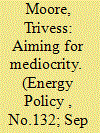| Srl | Item |
| 1 |
ID:
167000


|
|
|
|
|
| Summary/Abstract |
Concerns about climate change, energy security and energy productivity are driving countries to improve energy and thermal efficiency of their housing. Australia established a Nationwide House Energy Rating Scheme (NatHERS) in the mid-1990s to encourage improved energy performance, before regulating minimum energy standards in the 2000s. While minimum standards in Australia have improved, they fall short of requirements for a low carbon future. Resistance to new standards has been predicated on the argument that consumers will drive the market. Others argue that market failures result in lower than optimal house energy performance. There has been limited investigation of this in the Australian context. This paper analyses over 187,000 NatHERS certificates from 2016 to 2018 to determine the response to market desires and the regulatory environment. The research finds 81.7% of housing is designed only to meet minimum standards, and 98.5% falls below the economic and environmental optimum. This demonstrates significant market failure and indicates that building energy regulation is a powerful instrument for delivering improved performance outcomes. If governments are seeking a larger contribution from the housing sector to carbon abatement and other energy policies, systematically raising minimum building energy regulations is probably the most important and effective mechanism.
|
|
|
|
|
|
|
|
|
|
|
|
|
|
|
|
| 2 |
ID:
115164


|
|
|
|
|
| Publication |
2012.
|
| Summary/Abstract |
Reducing CO2-e emissions from residential buildings through more stringent building codes has gained increasing international focus. Concurrently, Australian houses have steadily increased in size from 1984 to 2009. This paper estimates the capacity of building codes to reduce residential emissions and achieve progressive reduction targets in light of increasing house sizes. A Residential Emissions Calculator was developed to compare heating and cooling loads for 72 new Australian houses-based on star ratings, historic Australian house sizes by state, and international house sizes. The analysis illustrates that house size has significant impact on the capacity of residential building codes to reduce emissions, and informs three key results: (1) Victoria is forecast to dominate emissions from new houses in Australia, (2) The increase in house size from 2003 to 2009 in Victoria decreased the effectiveness of moving from 5 stars to 6 stars by 38%, (3) Progressive CO2-e reduction targets of 80% could be achieved by a variety of house size and star rating scenarios (with significant housing affordability impacts). The result posit building codes and house size as potent strategies to limit energy associated emissions and underlines the need to apply these strategies in tandem as part of integrated national emissions management policy.
|
|
|
|
|
|
|
|
|
|
|
|
|
|
|
|